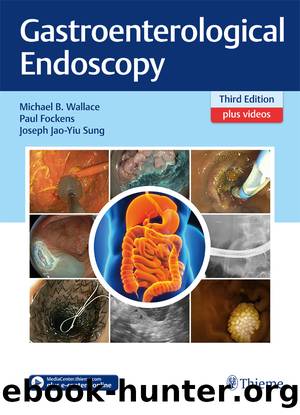Gastroenterological Endoscopy by Michael B. Wallace Paul Fockens Joseph Jao-Yiu Sung

Author:Michael B. Wallace,Paul Fockens,Joseph Jao-Yiu Sung
Language: eng
Format: epub
Publisher: Thieme Medical Publishing Inc.
Published: 2018-01-08T00:00:00+00:00
27.2.5 Esophagorespiratory Fistulas
Fistulas between the gastrointestinal and respiratory tracts are sometimes encountered in patients with advanced esophageal cancer as a complication of radiation therapy, chemotherapy, or in the setting of advanced disease. Coughing, recurrent aspiration, fever, dysphagia, and pneumonia are the most common presenting symptoms, and diagnosis can be made by fluoroscopic or CT imaging, or by direct endoscopic or bronchoscopic visualization53 (Fig. 27.7). The most common fistulas, esophagotracheal (tracheoesophageal [TEF]) account for over 50% of fistulas, but esophagobronchial or esophagopulmonary fistulas (communication through lung parenchyma) can also occur.54 TEF develop in about 5 to 15% of patients with esophageal cancer, and much less commonly (< 1%) in patients with bronchogenic carcinoma.55 Patients with esophagorespiratory fistulae have an average survival of less than 6 weeks with supportive care alone.54 Surgical approaches via esophageal bypass or diversion carry a very high complication and mortality rate, and for those reasons are now rarely performed. Instead, esophagorespiratory fistulas are most commonly managed by interventional modalities, such as esophageal and/or respiratory stents, clips, or suture placement.56
Download
This site does not store any files on its server. We only index and link to content provided by other sites. Please contact the content providers to delete copyright contents if any and email us, we'll remove relevant links or contents immediately.
Periodization Training for Sports by Tudor Bompa(8144)
Why We Sleep: Unlocking the Power of Sleep and Dreams by Matthew Walker(6592)
Paper Towns by Green John(5061)
The Immortal Life of Henrietta Lacks by Rebecca Skloot(4500)
The Sports Rules Book by Human Kinetics(4267)
Dynamic Alignment Through Imagery by Eric Franklin(4095)
ACSM's Complete Guide to Fitness & Health by ACSM(3972)
Kaplan MCAT Organic Chemistry Review: Created for MCAT 2015 (Kaplan Test Prep) by Kaplan(3921)
Introduction to Kinesiology by Shirl J. Hoffman(3709)
Livewired by David Eagleman(3662)
The Death of the Heart by Elizabeth Bowen(3530)
The River of Consciousness by Oliver Sacks(3517)
Alchemy and Alchemists by C. J. S. Thompson(3434)
Bad Pharma by Ben Goldacre(3277)
Descartes' Error by Antonio Damasio(3208)
The Emperor of All Maladies: A Biography of Cancer by Siddhartha Mukherjee(3043)
The Gene: An Intimate History by Siddhartha Mukherjee(3029)
The Fate of Rome: Climate, Disease, and the End of an Empire (The Princeton History of the Ancient World) by Kyle Harper(2988)
Kaplan MCAT Behavioral Sciences Review: Created for MCAT 2015 (Kaplan Test Prep) by Kaplan(2919)
